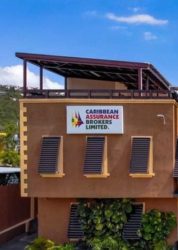Caribbean Producers jumped sharply in trading on Monday in a surprise move, with the price hitting $3.20, a level not seen since mid-April last year as activity on the Jamaica Stock Exchange Junior Market remained at a high level with all but four stocks trading, with 29 percent fewer shares at 30 percent less value than on Friday.
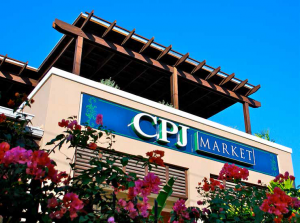
Caribbean Producers in a surprise move on Monday.
Trading ended with 40 securities changing hands, up from 35 on Friday with 12 rising, 15 declining and 13 remaining unchanged.
At the close, the Junior Market Index lost 27.24 points to settle at 2,871.89. The average PE Ratio ends at 15.3 based on ICInsider.com’s forecast of 2020-21 earnings.
Traders exchanged 6,033,662 shares for $17,830,831 down from 8,506,807 units at $25,313,437 on Friday. Derrimon Trading led with 19.3 percent of the volume, after an exchange of 1.17 million shares, followed by Mailpac Group with 15.5 percent of the day’s trade for 932,663 stocks and Lumber Depot with 14.7 percent for 884,021 units.
Trading averaged 150,842 units at $445,771 in contrast to 243,052 at $723,241 on Friday. Trading month to date averaged 379,631 units at $925,038, down from 397,540 units at $962,554 on Friday. Trading in January averaged 232,651 units at $569,885 trading.
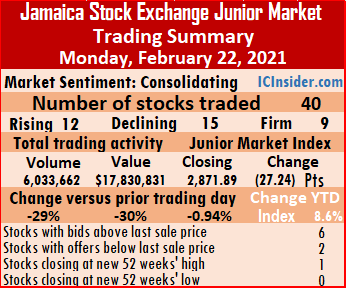 Investor’s Choice bid-offer indicator reading shows five stocks ending with bids higher than their last selling prices and two with lower offers.
Investor’s Choice bid-offer indicator reading shows five stocks ending with bids higher than their last selling prices and two with lower offers.
At the close of trading, AMG Packaging fell 17 cents to $1.63, with an exchange of 44,000 shares, CAC 2000 climbed $1.40 to $10.90 trading 500 units, Caribbean Assurance Brokers rose 9 cents to $1.85, in a transfer of 1,419 stock units. Caribbean Producers rose 53 cents to end at $3.20, with 752,023 shares crossing the market, Consolidated Bakeries picked up 5 cents in closing at $1.50, with 850 stocks changing hands, Dolphin Cove shed 30 cents to $7.70, with 1,162 stock units clearing the market. Everything Fresh lost 7 cents to end at 73 cents, with an exchange of 123,189 stocks, Express Catering dropped 35 cents to $3.30, with 1,100 units clearing the market, General Accident rose 21 cents to $5.51 trading 9,290 stock units, Jamaican Teas gained 9 cents to finish at $3.46 after a transfer of 585,809 shares. Jetcon Corporation lost 11 cents to end at 66 cents in trading 18,899 units, Lasco Distributors slipped 8 cents to $3.60, with 36,305 stock units changing hands, Mailpac Group lost 11 cents to close at $3.64 with 932,663 shares clearing the market, Main Event rose 41 cents to $3.45 in switching ownership of 3,133 units.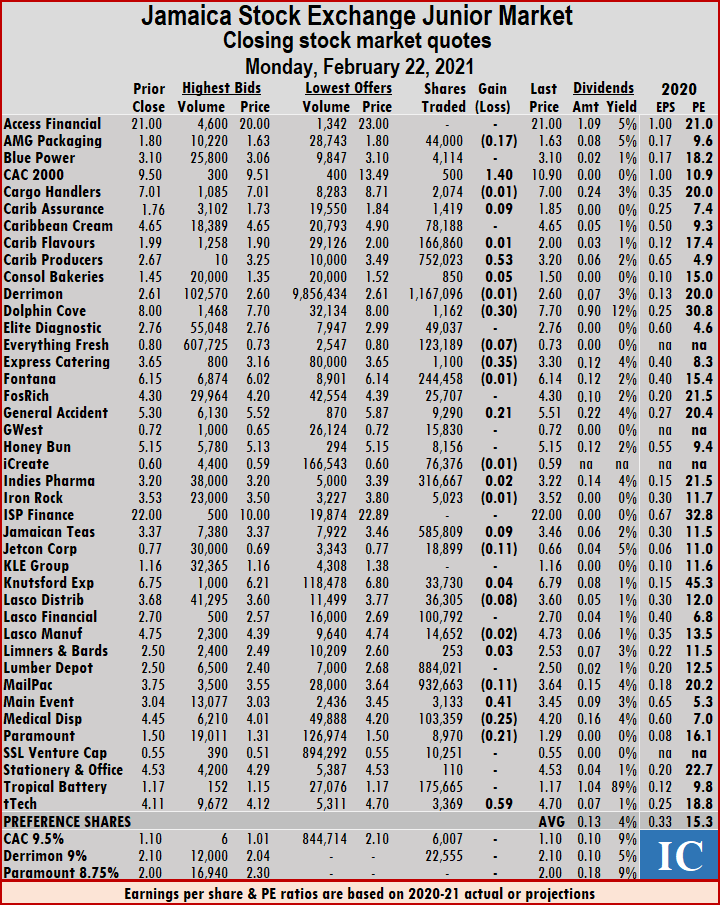 Medical Disposables shed 25 cents in ending at $4.20, with 103,359 stock units crossing the market, Paramount Trading dipped 21 cents to $1.29 trading 8,970 stocks and tTech advanced 59 cents to $4.70, trading 3,369 shares.
Medical Disposables shed 25 cents in ending at $4.20, with 103,359 stock units crossing the market, Paramount Trading dipped 21 cents to $1.29 trading 8,970 stocks and tTech advanced 59 cents to $4.70, trading 3,369 shares.
Prices of securities trading are those for the last transaction of each stock unless otherwise stated.
 At the close, the All Jamaican Composite Index gained 1,612.03 points to 430,576.51, the Main Index climbed 1,458.81 points to 392,702.80 and the JSE Financial Index gained 0.87 points to settle at 100.46.
At the close, the All Jamaican Composite Index gained 1,612.03 points to 430,576.51, the Main Index climbed 1,458.81 points to 392,702.80 and the JSE Financial Index gained 0.87 points to settle at 100.46.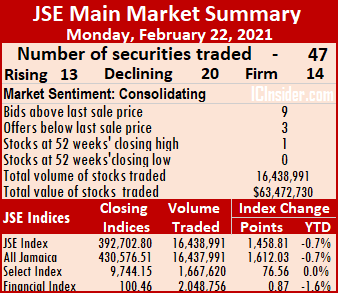 Investor’s Choice bid-offer indicator shows nine stocks ending with bids higher than their last selling prices and four with lower offers.
Investor’s Choice bid-offer indicator shows nine stocks ending with bids higher than their last selling prices and four with lower offers. Seprod climbed $2.15 to $69, with 16,385 stock units changing hands, Stanley Motta lost 25 cents in closing at $5.20 trading 418 shares and Sygnus Credit Investments rose $1.17 to $15.60, in transferring 69,924 stocks.
Seprod climbed $2.15 to $69, with 16,385 stock units changing hands, Stanley Motta lost 25 cents in closing at $5.20 trading 418 shares and Sygnus Credit Investments rose $1.17 to $15.60, in transferring 69,924 stocks. Trading ended with four securities changing hands, down from seven on Friday, ending with three rising and one declining, with the JSE USD Equity Index gaining 3.99 points to 196.07. The PE Ratio averages 13.7 based on ICInsider.com’s forecast of 2020-21 earnings.
Trading ended with four securities changing hands, down from seven on Friday, ending with three rising and one declining, with the JSE USD Equity Index gaining 3.99 points to 196.07. The PE Ratio averages 13.7 based on ICInsider.com’s forecast of 2020-21 earnings.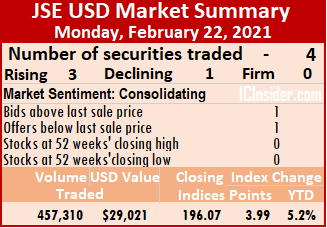 At the close of the market, First Rock Capital gained 0.09 of a cent in closing at 8.99 US cents, with 153,079 stock units crossing the market, Proven Investments rose 0.01 of a cent to close at 26 US cents trading 48,631 shares. Sterling Investments lost 0.19 of a cent at 2.20 US cents after trading 24,343 stocks and Transjamaican Highway rose 0.03 of a cent in closing at 0.94 of a US cents after switching ownership of 231,257 shares.
At the close of the market, First Rock Capital gained 0.09 of a cent in closing at 8.99 US cents, with 153,079 stock units crossing the market, Proven Investments rose 0.01 of a cent to close at 26 US cents trading 48,631 shares. Sterling Investments lost 0.19 of a cent at 2.20 US cents after trading 24,343 stocks and Transjamaican Highway rose 0.03 of a cent in closing at 0.94 of a US cents after switching ownership of 231,257 shares.
 Massy Holdings climbed 55 cents to $63 trading of 2,117 stock units, National Enterprises rose 1 cent to $3.12 trading 200 stock units, National Flour Mills fell 1 cent to $2.35 exchanging 52,572 units. NCB Financial Group settled at $8.50 trading 8,042 stock units, Republic Financial Holdings rose 5 cents to $135 after 55,042 shares crossed the exchange, Scotiabank ended at $56 in swapping 3,234 units. Trinidad & Tobago NGL shed 44 cents to $15.10 in an exchange of 901 shares, Unilever Caribbean declined 16 cents, ending at a 52 weeks’ low of $16.33 in switching ownership of 13,373 units and West Indian Tobacco rose $1.75 to $34.85 and trading 2,320 stock units.
Massy Holdings climbed 55 cents to $63 trading of 2,117 stock units, National Enterprises rose 1 cent to $3.12 trading 200 stock units, National Flour Mills fell 1 cent to $2.35 exchanging 52,572 units. NCB Financial Group settled at $8.50 trading 8,042 stock units, Republic Financial Holdings rose 5 cents to $135 after 55,042 shares crossed the exchange, Scotiabank ended at $56 in swapping 3,234 units. Trinidad & Tobago NGL shed 44 cents to $15.10 in an exchange of 901 shares, Unilever Caribbean declined 16 cents, ending at a 52 weeks’ low of $16.33 in switching ownership of 13,373 units and West Indian Tobacco rose $1.75 to $34.85 and trading 2,320 stock units.
 Caribbean Cream – EPS 95 cents Current PE 5.
Caribbean Cream – EPS 95 cents Current PE 5.
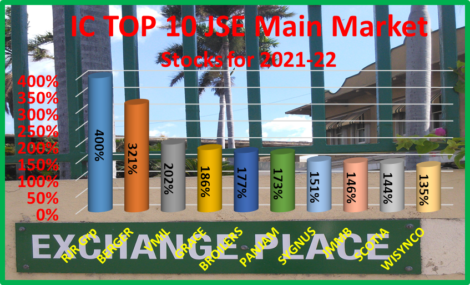
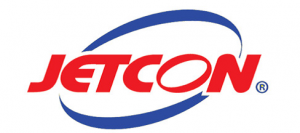 Jetcon Corporation – EPS 15 cents Current PE 5
Jetcon Corporation – EPS 15 cents Current PE 5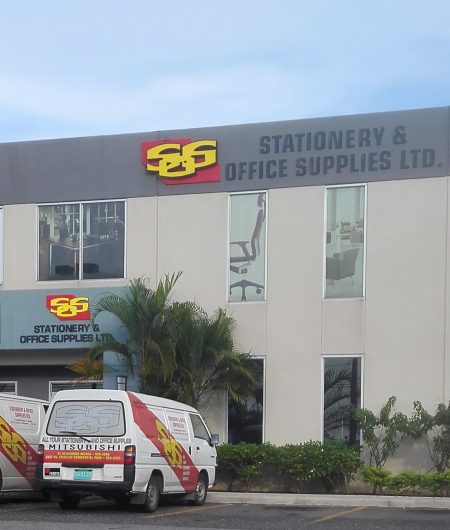



 This publication has been rightly calling for all prospectuses to include forecasts of income and profits for three years at a minimum, but prior to the FESCO issue only new companies have been doing so. The lack of forecast is a disservice to the investing public.
This publication has been rightly calling for all prospectuses to include forecasts of income and profits for three years at a minimum, but prior to the FESCO issue only new companies have been doing so. The lack of forecast is a disservice to the investing public.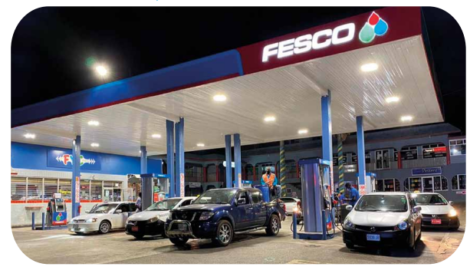 ”FESCO’s current market share of transportation fuels at September 2020 is 4.65 percent up from 3.8 percent in 2019 and 3.5 percent in 2018 and it estimates that its market share will increase to 5.3 percent by March 2021 and 7 percent by December 2021”, the prospectus further stated.
”FESCO’s current market share of transportation fuels at September 2020 is 4.65 percent up from 3.8 percent in 2019 and 3.5 percent in 2018 and it estimates that its market share will increase to 5.3 percent by March 2021 and 7 percent by December 2021”, the prospectus further stated.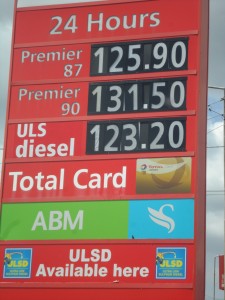 The projection for revenues to March this year is $6 billion, with profit of $151 million for earnings per share before tax of 7 cents and a price earnings ratio of 11.4 that compares well to
The projection for revenues to March this year is $6 billion, with profit of $151 million for earnings per share before tax of 7 cents and a price earnings ratio of 11.4 that compares well to  Trading averaged 244,928 units at $1,247,943, compared to 240,393 shares at $954,393 on Thursday. The month to date averaged 388,213 units at $2,506,158 in contrast to 399,327 units at $2,608,760 on Thursday. Trading in January averaged 311,275 units at $1,432,133.
Trading averaged 244,928 units at $1,247,943, compared to 240,393 shares at $954,393 on Thursday. The month to date averaged 388,213 units at $2,506,158 in contrast to 399,327 units at $2,608,760 on Thursday. Trading in January averaged 311,275 units at $1,432,133.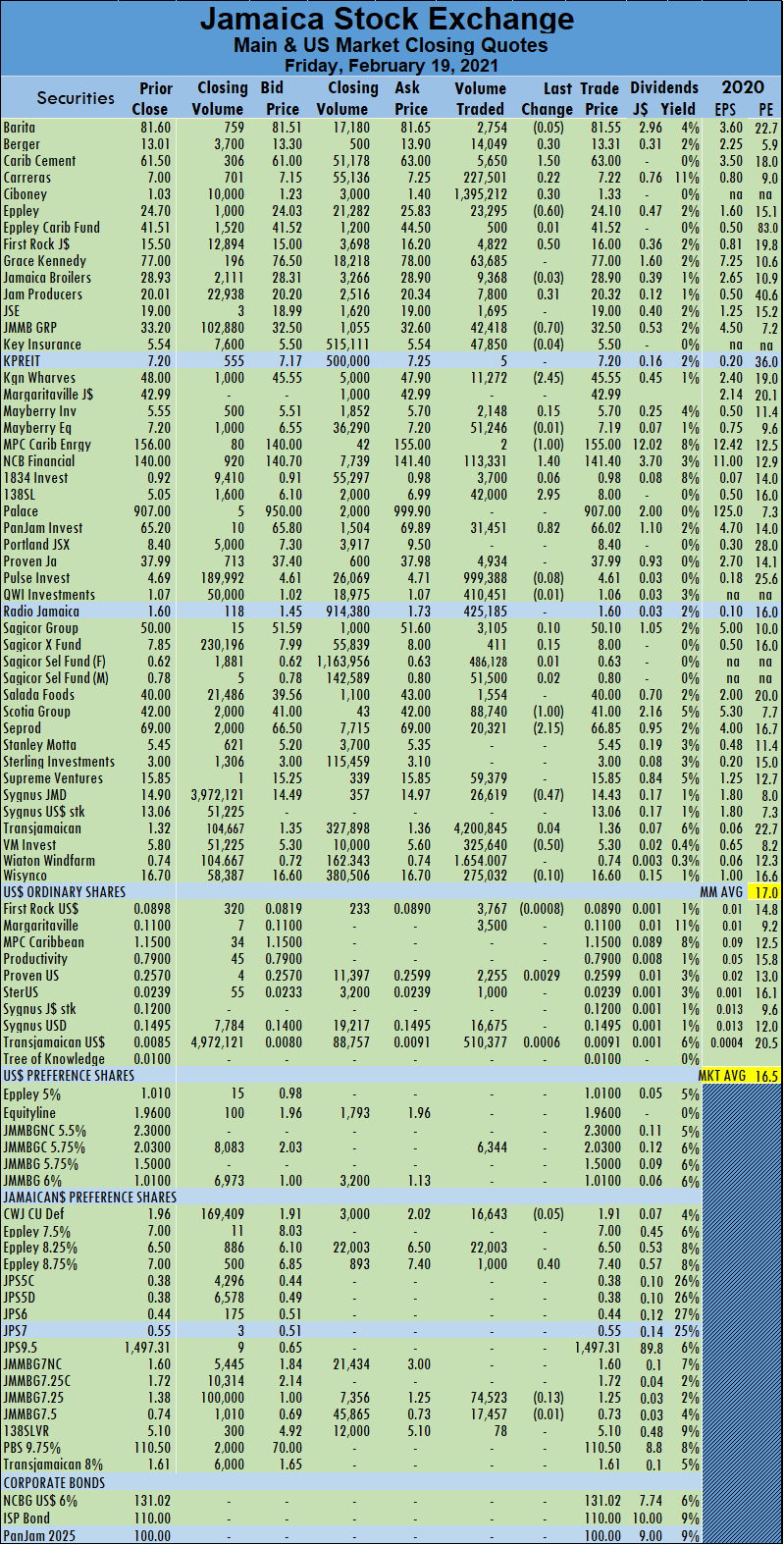 Scotia Group dropped $1 to $41 after exchanging 88,740 units, Seprod declined $2.15 to $66.85, with the swapping of 20,321 shares, Sygnus Credit Investments lost 47 cents to end at $14.43, with 26,619 stock units crossing the exchange. Victoria Mutual Investments closed 50 cents lower at $5.30, with 325,640 stocks changing hands.
Scotia Group dropped $1 to $41 after exchanging 88,740 units, Seprod declined $2.15 to $66.85, with the swapping of 20,321 shares, Sygnus Credit Investments lost 47 cents to end at $14.43, with 26,619 stock units crossing the exchange. Victoria Mutual Investments closed 50 cents lower at $5.30, with 325,640 stocks changing hands.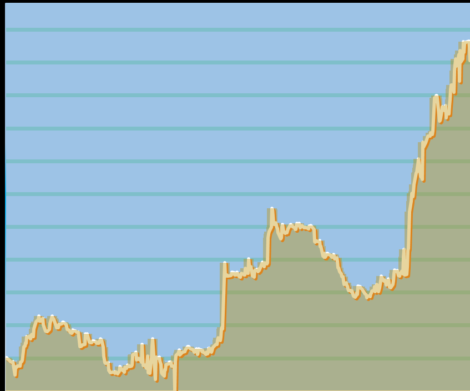 Trading ended with 35 securities changing hands, down from 37 on Thursday, with prices of 14 stocks rising, 10 declining and 11 remaining unchanged. The Junior Market Index advanced 21.44 points to 2,899.13. The average PE Ratio ends at 15.3 based on ICInsider.com’s forecast of 2020-21 earnings.
Trading ended with 35 securities changing hands, down from 37 on Thursday, with prices of 14 stocks rising, 10 declining and 11 remaining unchanged. The Junior Market Index advanced 21.44 points to 2,899.13. The average PE Ratio ends at 15.3 based on ICInsider.com’s forecast of 2020-21 earnings.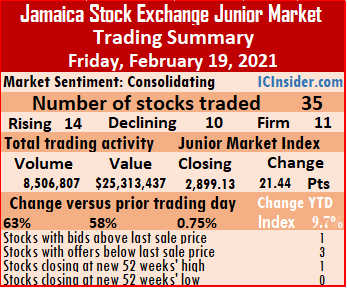 Investor’s Choice bid-offer indicator reading shows one stock ending with the bid higher than the last selling price and three with lower offers.
Investor’s Choice bid-offer indicator reading shows one stock ending with the bid higher than the last selling price and three with lower offers. Mailpac Group lost 4 cents to close at $3.75 while exchanging 502,880 shares, Paramount Trading gained 21 cents to close at $1.50 with 51,390 units crossing the exchange and Stationery and Office Supplies rose 31 cents to $4.53 after exchanging 259 units.
Mailpac Group lost 4 cents to close at $3.75 while exchanging 502,880 shares, Paramount Trading gained 21 cents to close at $1.50 with 51,390 units crossing the exchange and Stationery and Office Supplies rose 31 cents to $4.53 after exchanging 259 units.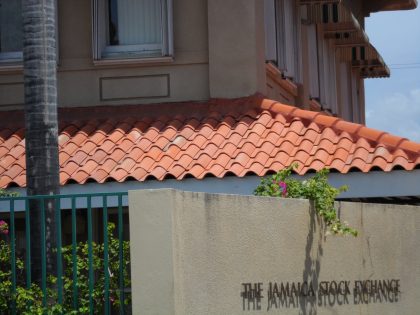 Trading closed with the prices of two stocks rising, one declining and four remaining unchanged, with the JSE USD Equity Index losing 1.15 points to end at 192.08. The PE Ratio averages 13.7 based on ICInsider.com forecast of 2020-21 earnings.
Trading closed with the prices of two stocks rising, one declining and four remaining unchanged, with the JSE USD Equity Index losing 1.15 points to end at 192.08. The PE Ratio averages 13.7 based on ICInsider.com forecast of 2020-21 earnings. At the close of the market, First Rock Capital shed 0.08 of a cent to close at 8.9 US cents, in exchanging 3,767 stocks, Margaritaville settled at 11 US cents with the transfer of 3,500 stock units, Proven Investments gained 0.29 of a cent to close at 25.99 US cents trading 2,255 units. Sterling Investments ended at 2.39 US cents, with 1,000 stock units changing hands, Sygnus Credit Investments remained at 14.95 US cents after transferring 16,675 shares and Transjamaican Highway gained 0.06 of a cent in closing at 0.91 of a US cent, trading 510,377 shares.
At the close of the market, First Rock Capital shed 0.08 of a cent to close at 8.9 US cents, in exchanging 3,767 stocks, Margaritaville settled at 11 US cents with the transfer of 3,500 stock units, Proven Investments gained 0.29 of a cent to close at 25.99 US cents trading 2,255 units. Sterling Investments ended at 2.39 US cents, with 1,000 stock units changing hands, Sygnus Credit Investments remained at 14.95 US cents after transferring 16,675 shares and Transjamaican Highway gained 0.06 of a cent in closing at 0.91 of a US cent, trading 510,377 shares.


